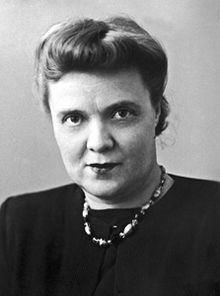Nationality Latvian Role Artist | Name Elena Skuin Movement Realism | |
 | ||
Died 1986, Saint Petersburg, Russia Known for Painting, Visual arts education | ||
Education Imperial Academy of Arts | ||
Elena Petrovna Skuin (Russian: Еле́на Петро́вна Скуи́нь, April 2, 1908, Ekaterinodar, Russian Empire – 1986, Leningrad, USSR) was a Soviet, Russian – Latvian painter, watercolorist, graphic artist, and art teacher, lived and worked in Leningrad, a member of the Leningrad Union of Artists, regarded as one of representatives of the Leningrad school of painting, most famous for her still life painting.
Biography
Elena Petrovna Skuin was born April 2, 1908 in Ekaterinodar, Kuban Oblast, Russian Empire, in the teacher's family, who arrived in the Kuban from Riga. After graduation nine-years high school she studied in 1926-1930 at the Kuban Teachers College, where she gained first professional skills of the painter. After graduating from college in 1930-1931 she taught drawing in high school in Krasnodar. Ability to draw, a bright character and a desire to improve in their chosen profession identified further choice of the path.
In 1931 Elena Skuin comes to Leningrad, worked as an artist at the Stalin Metal works, then studied at the Institute for Advanced education of Art workers.
In 1936 Elena Skuin entered at the third course of painting department of the Leningrad Institute of Painting, Sculpture and Architecture. She studied of Semion Abugov, Genrikh Pavlovsky, Dmitry Mitrokhin, Rudolf Frentz.
In 1939 Elena Skuin graduated from Leningrad Institute of Painting, Sculpture and Architecture in Alexander Osmerkin personal Art Studio. Her graduate work was genre painting named "Lesson of the circle, studying the Naval Science" (Museum of Academy of Arts, Saint Petersburg).
In October 1939 Elena Skuin was admitted to the Leningrad Union of Soviet Artists, receiving a membership card number 285. In 1940-1941, by the invitation of Professor Rudolf Frentz she works as an assistant in his studio of battle painting of the Leningrad Institute of Painting, Sculpture and Architecture.
After the beginning of Great Patriotic War Elena Skuin and her daughter were evacuated to Kazakhstan in city Leninsk-Kuznetsk. There she worked as an artist of Drama Theater named after S. Ordzhonikidze, participated in the design of the city, as well as exhibitions of artists of Kuzbass.
In 1944 Elena Skuin returned to Leningrad. She began her teaching job, first in the Secondary Art School at the Leningrad Institute of Painting, Sculpture and Architecture named after Ilya Repin, then at the Department of General Painting in Vera Mukhina Institute. At the same time she works a lot creatively and participated in most exhibitions of Leningrad artists. She painted genre paintings, portraits, still lifes, and landscapes. She worked in oil painting, watercolors, charcoal drawings. The greatest success and recognition achieved in the genre of still life paintings and watercolors.
In 1951 Elena Skuin leave teaching and move to work under contracts with LenIzo (Commercial Association of Leningrad Artists) as an artist of painting. It was during this period of still life is establishing itself as the leading genre in her work. This is evidenced by the work shown at the Spring exhibitions of Leningrad artists in 1954 and 1955 years, and the Autumn exhibitions in 1956 and 1958 years. Still lifes with flowers and fruits that are painted by her in this period were frankly fictional, masterfully orchestrated, elegant and solemn talking about the fullness and joy of life.
In 1960s Elena Skuin made some creative journeys in search of material for paintings, including her native Kuban land. Their results led to numerous sketches done from the life, also paintings "Tobacco of Kuban", "In horticulture" (both 1962), "Tobacco", "Garden Still Life" (both 1964), and others, as well as turn in the manner of her painting. After trips to the Kuban tonal painting techniques are giving way to decorative painting. The leading place in her works is given color spot, specifying the character of the composition. For her manners are typical of a bright saturated colors, exquisite color relationships, broad painting, decorative and upbeat attitude.
A peak of her decorative painting comes in the works of 1971 "Dark-blue buckets", and "Still Life with red balloons". Here the color spot conveys the shape of objects with modeling just one silhouette. The brevity decision created at the same time a wide range of associations. A color of objects, ordinary and familiar, becomes self-sufficient, and received semi-mystical importance, with a deep richness of overtones, with a broad associative, emotional content. Among her famous paintings of this period are "Still Life with Quince", "Still Life with Fish" (both 1961), "Begonia", "Watering can and Roses" (both 1964), "Violets" (1965), "Still Life with Jug and persimmon", "Blue Still Life" (both 1968), "The branch of the Apricot Tree" (1968), "Wistarias", "Lacemaker" (both 1969), "Evening Primrose and Cyclamen" (1971), "Favorite profession. Florists" (1975), "Lilacs", "The Apple Tree in Blossom" (both 1980), and others.
In 1970s Elena Skuin lot works in watercolor. Such works as "Still Life with bluebell" (1969), "Old English china and pineapple" (1971), "Red Corner" (1974), and others can be attributed her as outstanding master of watercolors. Owning a variety of watercolor techniques, she created a vivid memorable images close contemporary of the objective world, passing its aesthetic value and giving warmth things that make our everyday environment.
Her solo exhibitions were in Leningrad (1978) and Saint Petersburg (2005).
Elena Petrovna Skuin died in Leningrad in 1986. Her paintings reside in State Russian Museum, in Art museums and private collections in Russia, in the U.S., Japan, Germane, England, France, and throughout the world.
